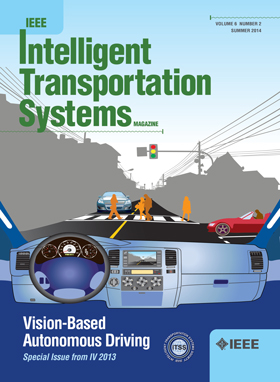A Surrogate Approach for Real-Time Stress Assessment of Urban Drivers Using Driving Video Data
IF 7.9
1区 工程技术
Q1 ENGINEERING, CIVIL
IEEE Transactions on Intelligent Transportation Systems
Pub Date : 2025-02-18
DOI:10.1109/TITS.2025.3538647
引用次数: 0
Abstract
Assessing driver stress can enhance Autonomous Vehicles’ (AVs) ability to recognize potential hazards in human-machine cooperative driving. In this study, we use a scene graph technique from the driver’s perspective as an intermediate representation for stress assessment, effectively modeling the complexity of real driving scenarios. We develop a dynamic scene graph readout model based on Global Context-Aware Attention (GCAA) to capture the spatiotemporal variability of the environment. Our approach integrates a Multi-Relational Graph Convolution Network (MR-GCN) and a Long-Short Term Memory Network (LSTM) to evaluate driver stress using field data from Nanjing, China. Results show that our model significantly improves driver stress classification, particularly for critical stress levels, with a 65.3% increase in balanced accuracy and a 38% rise in F-score compared to the baseline. The addition of GCAA enhances accuracy further, with an average improvement of 51.7%. This demonstrates our model’s superior ability to understand the contextual relationships within driving scenarios, making it highly effective for AVs to assess driver status in complex situations and interact more efficiently with human drivers. Furthermore, our model achieves a balance between accuracy and inference speed, making it suitable for real-time assessment tasks.基于驾驶视频数据的城市驾驶员实时压力评估替代方法
对驾驶员压力进行评估可以提高自动驾驶汽车在人机协同驾驶中识别潜在危险的能力。在本研究中,我们从驾驶员的角度使用场景图技术作为压力评估的中间表示,有效地模拟了真实驾驶场景的复杂性。我们开发了一个基于全局上下文感知注意(GCAA)的动态场景图形读取模型来捕捉环境的时空变化。我们的方法集成了多关系图卷积网络(mrgcn)和长短期记忆网络(LSTM),利用中国南京的现场数据来评估驾驶员应力。结果表明,我们的模型显著提高了驾驶员压力分类,特别是对于临界压力水平,与基线相比,平衡精度提高了65.3%,f分数提高了38%。GCAA的加入进一步提高了准确率,平均提高了51.7%。这表明我们的模型在理解驾驶场景中的上下文关系方面具有卓越的能力,使自动驾驶汽车能够在复杂情况下高效地评估驾驶员的状态,并更有效地与人类驾驶员进行互动。此外,我们的模型在准确率和推理速度之间取得了平衡,使其适合于实时评估任务。
本文章由计算机程序翻译,如有差异,请以英文原文为准。
求助全文
约1分钟内获得全文
求助全文
来源期刊

IEEE Transactions on Intelligent Transportation Systems
工程技术-工程:电子与电气
CiteScore
14.80
自引率
12.90%
发文量
1872
审稿时长
7.5 months
期刊介绍:
The theoretical, experimental and operational aspects of electrical and electronics engineering and information technologies as applied to Intelligent Transportation Systems (ITS). Intelligent Transportation Systems are defined as those systems utilizing synergistic technologies and systems engineering concepts to develop and improve transportation systems of all kinds. The scope of this interdisciplinary activity includes the promotion, consolidation and coordination of ITS technical activities among IEEE entities, and providing a focus for cooperative activities, both internally and externally.
 求助内容:
求助内容: 应助结果提醒方式:
应助结果提醒方式:


